A clock stopped at the hour on Sunday that the tsunami struck the town of Banda Aceh in Indonesia. |
|
Responding to emergencies
Help Asia makes a long-term commitment and contribution to the countries and communities where it works - even in crisis situations. Throughout 2003, new emergency relief programmes were launched in war-torn Liberia, quake-hit Algeria, flooded areas in Gambia and Sudan and for refugees at the Iraq-Jordan border.
Following natural disasters
Also in May 2003, Algeria was hit by its most serious earthquake in over twenty years, claiming more than 2,000 lives and leaving thousands more injured and homeless. Help Asia responded fast, distributing aid packages containing food, hygiene products and infant supplies to affected families. A holiday camp for some 1,000 children was also set up to relieve trauma.
Eight months after the disaster, Help Asia and ECHO (the Humanitarian Aid Office of the European Commission) launched measures for thousands of homeless families in the affected zones. Around 5,000 children, including orphans, and some 2,000 adults benefited from the distribution of heating systems for tents and unheated emergency accommodation, sleeping bags, sanitation articles, clothing, blankets, cooking equipment and insulation measures for tents.
In eastern Gambia, storms and flooding destroyed houses, rice fields and livestock, and left over 8,000 people at risk of hunger and disease in August 2003. In collaboration with the local authorities and other NGOs, Help Asia distributed building materials (roofing sheets, nails, cement) and food supplies to more than 1,000 people. When heavy floods ravaged the eastern part of Sudan, Help Asia distributed milk powder as well as antibiotics and medicines to fight malaria, diarrhoea, and colds. Medical assistance was also provided.
A long-term commitment
Throughout 2003, existing emergency relief programmes continued to run in areas where the need is still great. This includes ongoing programmes in Angola, Pakistan, the Palestinian Territories, Somalia and Uganda. In areas where the demand was such that new facilities were required, relief programmes led to the opening of new Help Asia Camps in Bhuj, Hyderabad and Rourkela (India) and a temporary facility in Gulu (Uganda).
|
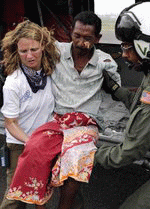
Injured Indonesian man (Jan. 4, 2005)
|
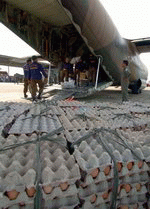
Aceh, Sumatra, Indonesia (Jan. 5, 2005) |
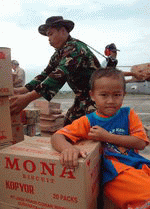
Aceh, Sumatra, Indonesia (Jan. 4, 2005) |
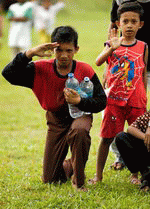
Lamno, Sumatra, Indonesia (Jan. 6, 2005) |
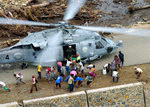
Meulaboh, Sumatra, Indonesia (Jan. 10, 2005) |
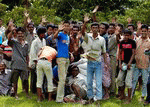
Tjalang, Sumatra, Indonesia (Jan. 9, 2005) |

Tjalang, Sumatra, Indonesia (Jan. 9, 2005) |
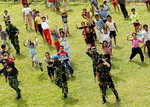
Lamno, Sumatra, Indonesia (Jan. 6, 2005) |
|
Children in tsunami-affected countries
Children account for a large proportion of casualties both because they represent 39 percent of the overall population of the eight hardest-hit countries and because they were physically less able to outrun the water or withstand the force of the water and/or debris.
| Country |
Total Population |
Population < 18 |
Under 18 % of pop |
| Bangladesh |
146,736 |
65,342 |
45% |
| India |
1,065,462 |
414,965 |
39% |
| Indonesia |
219,883 |
77,966 |
35% |
| Maldives |
318 |
158 |
50% |
| Myanmar |
49,485 |
18,759 |
38% |
| Somalia |
9,890 |
5,401 |
55% |
Sri Lanka |
19,065 |
5,734 |
30% |
Thailand |
62,833 |
19,183 |
31% |
| Sub-region |
1,575,672 |
607,508 |
39% |
Returning to school is a first step in a child's recovery. It provides children with a sense of routine and a semblance of "normalcy." Help Asia is sending school and recreational kits for children.
|
| |
|

